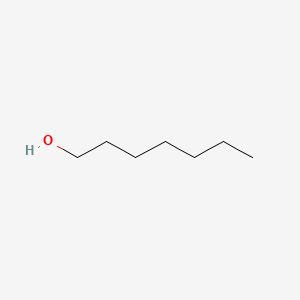| MeSH term | MeSH ID | Detail |
|---|---|---|
| Eye Burns | D005126 | 13 associated lipids |
| Ventricular Dysfunction, Left | D018487 | 33 associated lipids |
| Tachycardia, Ventricular | D017180 | 9 associated lipids |
| Heart Injuries | D006335 | 6 associated lipids |
| Wounds, Gunshot | D014948 | 2 associated lipids |
| Tachycardia, Ectopic Atrial | D013612 | 1 associated lipids |
n-heptanol
N-heptanol is a lipid of Fatty Acyls (FA) class. N-heptanol is associated with abnormalities such as Corneal Neovascularization. N-heptanol often locates in Epithelium and Structure of corneal epithelium. The related lipids are Heptanol.
Cross Reference
Introduction
To understand associated biological information of n-heptanol, we collected biological information of abnormalities, associated pathways, cellular/molecular locations, biological functions, related genes/proteins, lipids and common seen animal/experimental models with organized paragraphs from literatures.
What diseases are associated with n-heptanol?
n-heptanol is suspected in Corneal Neovascularization and other diseases in descending order of the highest number of associated sentences.
Related references are mostly published in these journals:
| Disease | Cross reference | Weighted score | Related literature |
|---|
Possible diseases from mapped MeSH terms on references
We collected disease MeSH terms mapped to the references associated with n-heptanol
PubChem Associated disorders and diseases
What pathways are associated with n-heptanol
There are no associated biomedical information in the current reference collection.
PubChem Biomolecular Interactions and Pathways
Link to PubChem Biomolecular Interactions and PathwaysWhat cellular locations are associated with n-heptanol?
Visualization in cellular structure
Associated locations are in red color. Not associated locations are in black.
Related references are published most in these journals:
| Location | Cross reference | Weighted score | Related literatures |
|---|
What functions are associated with n-heptanol?
There are no associated biomedical information in the current reference collection.
What lipids are associated with n-heptanol?
Related references are published most in these journals:
| Lipid concept | Cross reference | Weighted score | Related literatures |
|---|
What genes are associated with n-heptanol?
There are no associated biomedical information in the current reference collection.
What common seen animal models are associated with n-heptanol?
There are no associated biomedical information in the current reference collection.
NCBI Entrez Crosslinks
All references with n-heptanol
Download all related citations| Authors | Title | Published | Journal | PubMed Link |
|---|---|---|---|---|
| Stevens SM et al. | Heptanol application to the mouse round window: a model for studying cochlear lateral wall regeneration. | 2014 | Otolaryngol Head Neck Surg | pmid:24436465 |
| Rogers EW and Molinski TF | Asymmetric synthesis of diastereomeric diaminoheptanetetraols. A proposal for the configuration of (+)-zwittermicin a. | 2007 | Org. Lett. | pmid:17249781 |
| Celestini P et al. | trans-6-Aminocyclohept-3-enols, a new designed polyfunctionalized chiral building block for the asymmetric synthesis of 2-substituted-4-hydroxypiperidines. | 2002 | Org. Lett. | pmid:11950364 |
| Huang AJ et al. | Induction of conjunctival transdifferentiation on vascularized corneas by photothrombotic occlusion of corneal neovascularization. | 1988 | Ophthalmology | pmid:2459642 |
| Chung JH et al. | Effect of topical Na-hyaluronan on hemidesmosome formation in n-heptanol-induced corneal injury. | 1998 | Ophthalmic Res. | pmid:9523287 |
| Yap AU et al. | Influence of dietary solvents on strength of nanofill and ormocer composites. | 2005 Jan-Feb | Oper Dent | pmid:15765968 |
| Adams JB et al. | Nutritional and metabolic status of children with autism vs. neurotypical children, and the association with autism severity. | 2011 | Nutr Metab (Lond) | pmid:21651783 |
| Young JS et al. | The origin of the skewed amplitude distribution of spontaneous excitatory junction potentials in poorly coupled smooth muscle cells. | 2007 | Neuroscience | pmid:17208381 |
| Hirasawa H et al. | Blocking AMPA receptor desensitization prolongs spontaneous EPSC decay times and depolarizes H1 horizontal cells in carp retinal slices. | 2001 | Neurosci. Res. | pmid:11448513 |
| Tarner IH et al. | Heptanol exerts epileptiform effects in identified neurons of the buccal ganglia of Helix pomatia. | 1999 | Neurosci. Lett. | pmid:10320017 |
